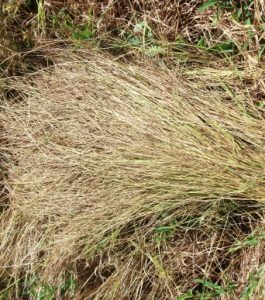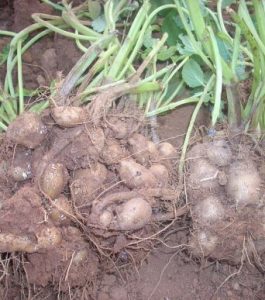 Common Name: Taro
Common Name: Taro
Description
Colocasia esculenta is a tropical plant grown primarily for its edible corms, the root vegetables most commonly known as taro. It is believed to be one of the earliest cultivated plants. Linnaeus originally described two species which are now known as Colocasia esculenta and Colocasia antiquorum of the cultivated plants that are known by many names including eddoes, dasheen, taro, but many later botanists consider them all to be members of a single, very variable species, the correct name for which is Colocasia esculenta . . . .Read more
References
Switchboard
Wikipedia
Annuals
Digitaria exilis
 Common Name: Fonio
Common Name: Fonio
Description
Digitaria exilis, with English common names white fonio, fonio millet, and hungry rice or acha rice, is a grass species. It is the most important of a diverse group of wild and domesticated Digitaria species known as fonio that are harvested in the savannas of West Africa. The grains are very small. It has potential to improve nutrition, boost food security, foster rural development and support sustainable use of the land. . . . .Read more
References
Switchboard
Wikipedia
Plectranthus rotundifolius
 Common Name: African Potato
Common Name: African Potato
Description
Plectranthus rotundifolius or Solenostemon rotundifolius, commonly known as native or country potato in Africa and called “Chinese potato” in India is a perennial herbaceous plant of the mint family (Lamiaceae) native to tropical Africa. It is cultivated for its edible tubers primarily in West Africa, as well as more recently in parts of Asia, especially India, Sri Lanka, Malaysia, and Indonesia.
P. rotundifolius is closely related to the coleus plants widely cultivated as ornamentals and is often classified as a member of the genus Solenostemon rather than Plectranthus. It was formerly placed in the now-defunct genus Coleus, most of whose members have now been re-assigned to the genus Solenostemon. . . . .Read more
References
Switchboard
Wikipedia
Corchorus olitorius
 Common Name: Jute mallow
Common Name: Jute mallow
Description
Corchorus olitorius, commonly known as Nalta jute, tossa jute, Jew’s mallow, West African sorrel and bush okra, is a species of shrub in the family Malvaceae. It is the primary source of jute fibre. The leaves and young fruits are used as a vegetable, the dried leaves are used for tea and as a soup thickener, and the seeds are edible.
. . . .Read more
References
Switchboard
Wikipedia